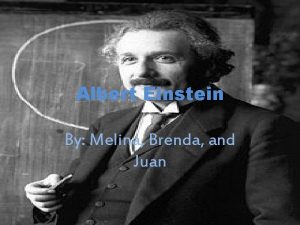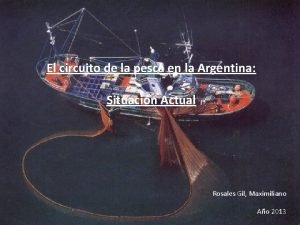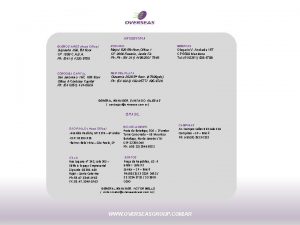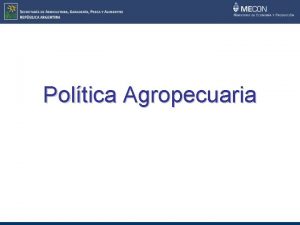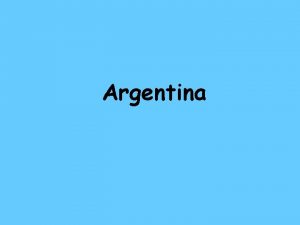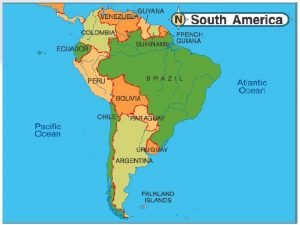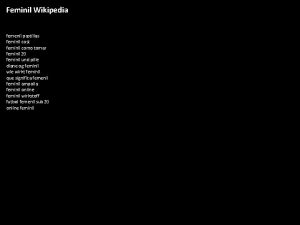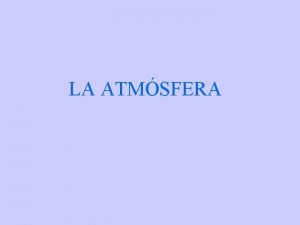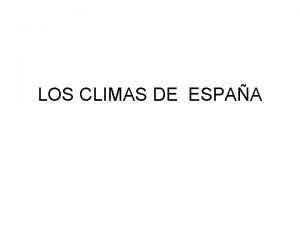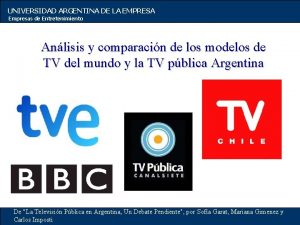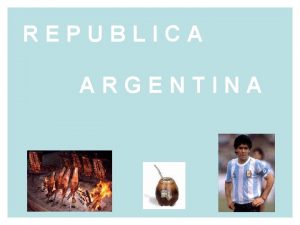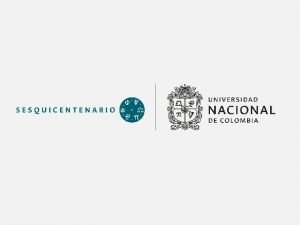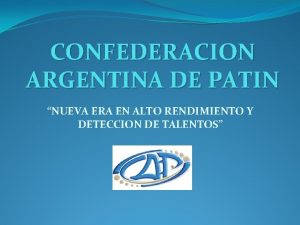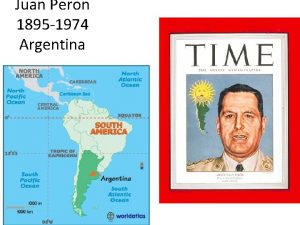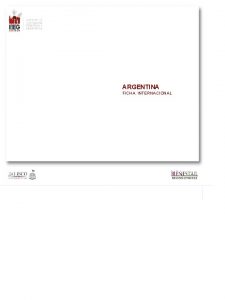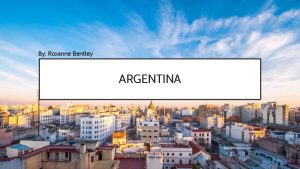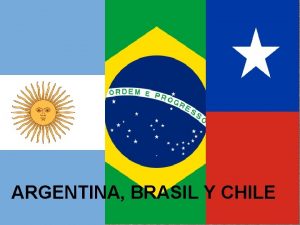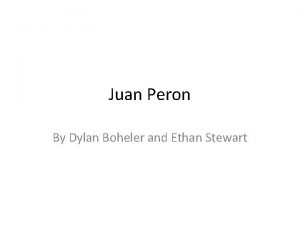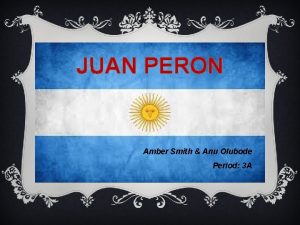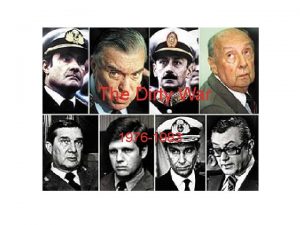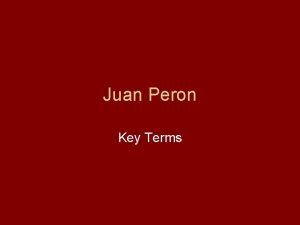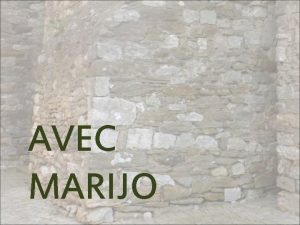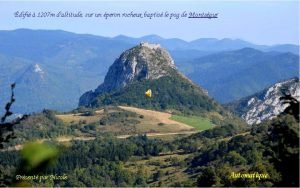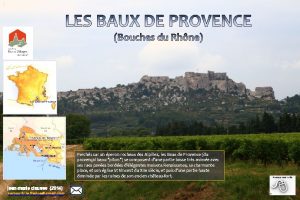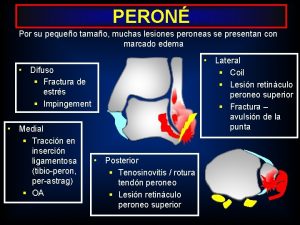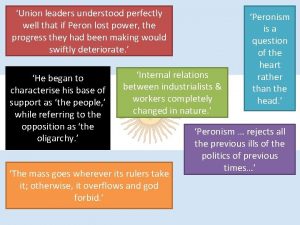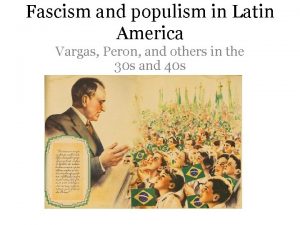4 19 17 Argentina Juan Eva Peron Aim





















- Slides: 21

4 -19 -17 Argentina –Juan & Eva Peron Aim: How has Argentina struggled to establish democratic rule? Do Now: Last term – we studied revolutions and the independence of Latin American nations. After independence, what kinds of problems did Latin American nations experience? (identify at least 2 -3 problems)

Background • Argentina was a Spanish Colony • 1810 -1818 War for Independence –Jose de San Martin • 1880 -1929 economic growth as major grain & beef exporter to the US & Europe • WWI – neutral • Great Depression 1929 -1943 -weak gov’t - Neutral WW 2 - Social unrest: high unemployment/ elite class…

Juan & Eva Peron Read History Makers Juan and Eva Peron Answer questions 1 & 2 in writing in your notebook. Based on the reading the video clips, answer Question # 3 in writingin your notebook

Argentina After World War II, Argentina and other Latin American countries saw a rise in dictatorships. Social and economic conditions allowed them to take tremendous power at the expense of people’s freedoms. Peronism Radical Changes • Juan Peron rose to power following military coup, 1943 • Wife Eva took charge of labor, social programs • Had great deal of help from wife, Eva • Peron created minimum wage, eight-hour workday, paid vacations • Proved to be populist, supporter of rights of common people, not the elite • Built schools, hospitals, shelters Downside • Tried, failed to boost industrialization • Placed cattle, wheat industries under government control; farm production plunged • Became dictator

Find the Main Idea How did dictatorships affect society in Argentina? Answer(s): people lived in fear; economy suffered

Check For Understanding • During the 19 th century, the economies in most Latin American countries relied primarily on the export of (1) cash crops (2) service jobs (3) hydroelectric power (4) factory-made goods • Which conclusion about Latin American political history could be reached after a study of the rise of power of Juan Peron in Argentina and Augusto Pinochet in Chile? (1) People will often support dictators who promise to restore stability. (2) The strongest leaders are those who are elected democratically. (3) Spain generally supported independence movements in Latin America. (4) Latin America has a strong tradition of monarchy.

4 -20 -17 Latin America & Cold War Aim: How did the Cold War impact Latin American nations? Do Now: Read Operation Condor: Why did Latin American governments suppress (put down with force) revolutionary activities? Operation Condor- Argentina, Bolivia, Brazil, Chile, Paraguay & Uruguay

Review of Cuba US gov’t supports Batista as dictator • Cuba very dependent on U. S. • 1950 s, hotels, casinos owned by wealthy Americans, Cuba’s elite • U. S. owned sugar, tobacco plantations • BACKFIRES • Many Castro revolutionaries, wanted Marxist regime • Castro focused on ending U. S. dominance, redistributing wealth, reforming society • Castro’s policies led many Cubans to leave country, many for U. S. ; caused economy to struggle • Castro relied on Soviet Union for economic support; Soviet collapse in 1991 hurt economy

• • • Nicaragua 1933 -1979 the Somoza family reigns (hereditary dictatorship) US supports Somoza family 1927 -1979 1950’s-1970’s economic growth benefitted few-like Somoza family (oil & beef exports) 1972 major earthquake – Somoza stole money 1979 Sandinistas lead revolution & seize power: US supports it 1980’s Contras vs. Sandinistas in civil war Then US supports Contras – Sandinistas help Marxists in El Salvador –US aides contras Daniel Ortega president (1985 -1990) moves toward communism 1990 election = democratic reforms 2006/ 2011/ 2016 Ortega re-elected Daniel Ortega

Argentina Military Dictatorships Dirty War • Peron’s downfall, 1955, followed by decades of economic, political turmoil • 1976 to 1983, government carried out “dirty war” against suspected dissidents • Right-wing military dictatorships ruled for many years • Secret war carried out in middle of night • Struggled with declining industry, rising unemployment, inflation, foreign debt • Soldiers took people from homes to detention centers, tortured, sometimes killed • Cracked down on dissent, limited personal freedoms • 10, 000 to 30, 000 victims vanished during this time

Argentina Victims of “dirty war, ” critics of government and those falsely accused of being critics • Desperate relatives tried to find out what happened to loved ones • Plaza de Mayo – Square outside government buildings in Buenos Aires – Group of mothers of disappeared marched every week – Did not get wanted answers – Brought national, international attention to tactics of Argentina’s military dictatorship

Chile As in Argentina, economic problems led to drastic changes in Chile’s government. Allende’s Presidency • Salvador Allende elected, 1970 • Tried to improve lives of workers, stimulate economy – Spent money on housing, education, health care – Broke up large estates, distributed land to peasants – Nationalized foreign-owned companies Trouble for Allende • After a time, industrial, farm production fell, prices rose, food shortages spread Allende’s leftist policies alienated business owners, worried U. S. government. • CIA led opposition, economy failed, military rebelled • Allende, 3, 000 others killed in coup, September 11, 1973

Chile The Pinochet Regime Destroyed Opposition • Augusto Pinochet appointed commander in chief of army a few weeks before coup • Pinochet took command of military junta following coup • General Pinochet closely involved in coup • Moved quickly to destroy opposition Pinochet’s Tactics • Became president, 1974 Period of Growth • Disbanded congress, censored media, suspended constitution, banned opposition parties • Despite political crackdown, economy experienced several periods of rapid growth • Arrested thousands who opposed government • Government promoted capitalism, exports grew

Summarize How did events in Chile lead to a dictatorship? Answer(s): economic problems, socialist-style policies, CIA provided funding and training to opposition, a coup took place

Check For Understanding One similarity in the results of the revolution led by Fidel Castro in Cuba and by the Sandinistas in Nicaragua is that both 1. Restored a monarchy 2. Destroyed a theocracy 3. Followed Marxist principles. 4. Protected freedom of the press *The Nazi Party controls Germany. *Khmer Rouge rules in Cambodia. *The Sandinistas control Nicaragua. Which statement describes a similarity in these situations? 1. Voting rights were extended to women. 2. One group seized power and limited opposition. 3. Civil liberties were promoted. 4. Leaders won the support of all groups.

--- continued check The governments of Augusto Pinochet, Saddam Hussein, and Slobodan Milosevic are examples of 1. Oppressive regimes 2. Absolute monarchies 3. Democratic republics 4. Islamic theocracies Which conclusion about Latin American political history could be reached after a study of the rise of power of Juan Peron in Argentina and Augusto Pinochet in Chile? 1. People will often support dictators who promise to restore stability. 2. The strongest leaders are those who are elected democratically. 3. Spain generally supported independence movements in Latin America. 4. Latin America has a strong tradition of monarchy.

4 -21 -17 LA nations & democracy Aim: How did authoritarian rule delay democracy in Latin America? Do Now: Define Democracy. What are some of the common practices of democracy? Authoritarian: strong central power expects obedience & allows limited freedoms

Master Group 1. Move into your assigned letter group – a, b, c, d, e 2. Read and review the resources given for your Latin American nation. 3. Take your own notes: IDENTIFY the country and leader. What conditions delayed democracy from happening? AND What conditions supported the development of a democratic government?

Share Out Group 1) Take a number 1, 2, 3, 4, 5, 2) Move into the designated area to meet with new group members. 3) Each member will SHARE out the information learned from the master group. 4) Each student will record the information and complete the chart in your notebook…volunteers to the board. Country Democracy Hindered Democracy supported

Review with class if time permits Country El Salvador – Nicaragua- Brazil- Argentina - Mexico. Chile- Haiti - Democracy Hindered Democracy supported

Final Summary Compare and contrast the struggle for democracy in Latin America to the struggle for democracy in African nations. -Include 2 -3 Facts, Examples, Details = Evidence… 1 similarity and 1 difference min. - You may choose to chart your answer or write 3 -5 sentences.
 Juan juan studio melina
Juan juan studio melina Circuito productivo de la pesca en argentina
Circuito productivo de la pesca en argentina Argentina dirty war timeline
Argentina dirty war timeline Cisv waterloo
Cisv waterloo Caccace
Caccace Climate zones south america
Climate zones south america Suipacha 268 caba
Suipacha 268 caba La argentina en el contexto mundial
La argentina en el contexto mundial Emilio pettoruti pensierosa
Emilio pettoruti pensierosa Primera división de argentina
Primera división de argentina Population of argentina
Population of argentina Feminil peru
Feminil peru Mapa fitogeográfico de argentina
Mapa fitogeográfico de argentina Los vientos locales de argentina
Los vientos locales de argentina Cuadro de los biomas de venezuela
Cuadro de los biomas de venezuela Empresas de entretenimiento en argentina
Empresas de entretenimiento en argentina Olsen restaurante
Olsen restaurante Puente zarate brazo largo mapa
Puente zarate brazo largo mapa Escala de calificaciones escolares
Escala de calificaciones escolares Confederacion argentina de patin
Confederacion argentina de patin Mapa argentina
Mapa argentina Juicio político argentina
Juicio político argentina
